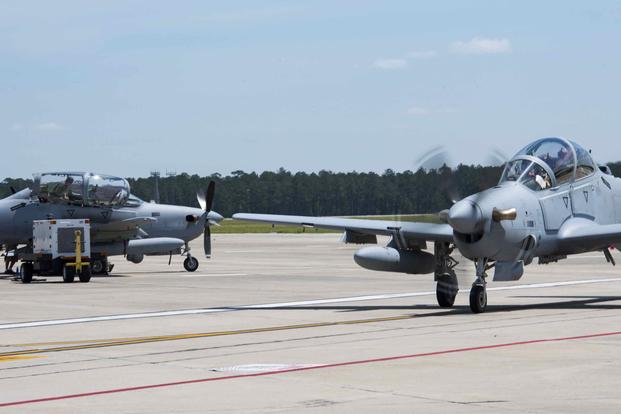After nearly five years, the U.S. Air Force is winding down its mission to teach Afghan pilots to fly the A-29 Super Tucano.
The service graduated its final class of Afghan air force student pilots as part of the 81st Fighter Squadron at Moody Air Force Base, Georgia, on Nov. 13, according to a release.
Read Next: In Shake-Up, Acting SecDef Elevates Special Operations to Be 'On Par' with Service Branches
Since its creation in 2015, the 81st has produced more than Afghan 30 pilots and trained 70 maintenance technicians on the turboprop light attack aircraft. The training program will now be based solely in Afghanistan, where Afghan instructor pilots will take over the training regiment, the Air Force said.
"The 81st truly built this program from the ground up -- developing both the [tactics, techniques and procedures] and the syllabus, and then delivering full-spectrum training that not only produced combat-ready attack pilots, but also a mindset that prevents civilian casualties to the greatest extent possible," said Kelli Seybolt, deputy under secretary of the Air Force for international affairs, in the release. "This group was one of the strongest classes we had in this program, which is a fitting way to conclude it."
Officials said the schoolhouse at Moody was able to cover a typical 13-month training syllabus in less than a year and included courses in night-vision training, low-level flight and employing precision-guided munitions.
Brazilian Air Force air advisers also aided in teaching students within the program. Embraer, the company that produces the A-29 in conjunction with Sierra Nevada Corporation, is based in Brazil.
"Their mission is not easy," H.E. Roya Rahmani, the Afghan ambassador to the United States, said in the release. "They are aware of the challenges and responsibilities that it entails; but they also realize it is not only important, but crucial, for future security of our country."
In 2016, Afghan pilots trained in the U.S. conducted their first close-air support missions in the A-29. The Pentagon that year said its goal was to train roughly 30 pilots, but as many as 90 maintainers, by at least 2018.
The Afghan air force then deployed a GBU-58 Paveway II bomb from the Super Tucano in combat in 2018, marking the first time the Afghan military had dropped a laser-guided weapon against the Taliban.
"While U.S. air power is destroying Taliban support elements in the deep fight, Afghan A-29s and MD-530 helicopters provide quick, lethal support to Afghan ground forces in the close fight," U.S. Air Force Maj. Gen. James Hecker, then the commander of NATO Air Command-Afghanistan, said at the time. Hecker, now a lieutenant general, is currently the president of Air University in Alabama.
In 2017, the Afghan air force conducted roughly 2,000 airstrike sorties -- about 40 strikes per week, Hecker said during a televised conference at the Pentagon. The AAF had a record high that October with more than 80 missions in a single week, he said, adding that a few pilots had been trained to drop laser-guided munitions.
According to a June 2020 Pentagon report to Congress, officials said the Afghan National Defense and Security Forces expressed confidence in the Afghan pilots' technical advancement in a fairly short timespan, as well as their dedication to minimize civilian casualties.
"There is an insatiable desire for precision munitions where in some cases conventional munitions could be employed," the report said. "Advisers continue to note that Afghan crews demonstrated consistent progress in target selection and collateral damage estimation and
showed impressive restraint and ability to minimize civilian casualties."
The Afghan air force has 28 aircraft ready for close-air support, air interdiction, escort and armed reconnaissance, according to a separate Special Inspector General for Afghanistan Reconstruction report.
The program made headlines in December 2015, when two male Afghan maintenance crew failed to report for duty at Moody. The two had been scheduled to graduate from the training program and then return to Afghanistan. One of the students was found a month later, according to ABC News.
Similarly, a program to train Afghan attack pilots on the AC-208 Combat Caravan at Fort Worth, Texas, ended in 2019 after more than half the pilots training there went absent without leave. The Texas-based program was able to produce only one graduating class, SIGAR said in its quarterly report, released that April.
Moody is still scheduled to host other foreign national pilots for future training.
In April, the Air Force said it will begin training Nigerian Air Force pilots at the base under the 81st. The training is set to become fully operational in the winter of 2021, the service said.
-- Oriana Pawlyk can be reached at oriana.pawlyk@military.com. Follow her on Twitter at @Oriana0214.
Related: Special Ops Plan to Buy New Light-Attack Fleet May Get Pushed Back













